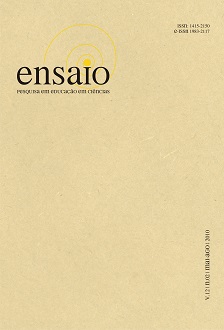RESTRIÇÕES COGNITIVAS NO LIVRO DIDÁTICO DE BIOLOGIA: UM ESTUDO A PARTIR DO TEMA "CICLO DO NITROGÊNIO"
COGNITIVE RESTRICTIONS IN THE BIOLOGY TEXTBOOK: A STUDY ON THE THEME "THE NITROGEN CYCLE"
DOI:
https://doi.org/10.1590/1983-21172010120209Palavras-chave:
Ensino de Biologia; Livro Didático; Memória Operacional; Carga Cognitiva.Resumo
Fundamentando-se em um modelo de aprendizagem a partir de recursos que fazem uso de texto verbal e imagem, e na teoria da carga cognitiva, o artigo analisa quatro coleções de livros didáticos de Biologia. Para nossa análise, elegemos como tema o "Ciclo do Nitrogênio". A aná lise evidenciou um planejamento instrucional inadequado, que sobrecar rega os recursos cognitivos do aluno. Assim, o estudo das quatro coleções indica a necessidade de que o planejamento e a construção de imagens para o livro didático de Biologia sejam orientados por preceitos e critérios que visem tornar o uso dos recursos pictóricos mais eficientes. Ao final, propomos algumas indicações para a área de pesquisa e ensino em Ciências e Biologia.
Based on a learning study on resources that use verbal text and image and the theory of cognitive load, the article analyzes four collec tions of Biology textbooks. For our analysis, we chose the theme "The Nitrogen Cycle", which showed inadequate instructional planning, over loading the cognitive resources of the student. Thus, the study of the four collections indicates the need for a better planning of images in the Biology textbook guided by criteria aiming to make the use of pictorial resources more effective. At the end we propose a few indications for the area of research and the teaching of Science and Biology.
Referências
AMABIS, J. M. E. e MARTHO, G. R. Biologia das Populações. São Paulo, Editora Moderna, 2004.
BADDELEY, A. Working memory. Science, 255: 556-559, 1992.
BADDELEY, A. A Short-term and working memory. In: Tulving, E. e Craik, F. I. M. (Eds.). The Oxford handbook of memory. Oxford: Oxford University Press, 2000, pp. 77-92.
BRUZZO, C. Biologia: educação e imagens. Educação e Sociedade, 25 (89): 1359-1378, 2004.
CAMPOS, A. F. Ciclo do nitrogênio: abordagem em livros didáticos de Ciências do Ensino Fundamental. Investigações em Ensino de Ciências, 13 (1): 35-44, 2008.
CÉSAR, S. J. e SEZAR, S. Biologia. Volume 3, São Paulo, Editora Saraiva, 2005.
KNORR-CETINA, K. e AMANN, K. Image Dissection in Natural Scientific Inquiry. Science, Technology and Human Values, 15: 259-283, 1990.
LEMKE, J. Multiplying meaning: Visual and verbal semiotics in scientific text. In: MARTIN, J. R. and VEEL, R. Reading Science. London: Routledge, 1998.
LINHARES, S. E. e GEWANDSZNAJDER, F. Biologia hoje, Volume 3. São Paulo, Editora Ática, 2003.
MARTINS, I.; GOUVÊA, G. e PICCININI, C. L. Aprendendo com imagens. Ciência e Cultura, 57 (4): 38-40, 2005.
MAYER, R. E. Multimedia learning. Cambridge, Cambridge University Press, 2001.
MAYER, R. e ANDERSON, R. B. Animations need narrations: an experimental test of dual-coding hypothesis. Journal of Educational Psychology, 83: 484-490, 1991.
MAYER, R. E. e ANDERSON, R. B.The instructive animation: helping students build connections between words and pictures in multimedia learning., Journal of Educational Psychology 84: 444 -452, 1992.
MAYER, R. E. e GALLING, J. K. When is an illustration worth ten thousand words?, Journal of Educational Psychology 82: 715-726, 1990.
PAULINO, W. R. Biologia Atual, Volume 3. São Paulo, Editora Ática, 2002.
PICCININI, C. e MARTINS, I.Comunicação multimodal na sala de aula de Ciências: construin do sentidos com palavras e gestos. Ensaio: pesquisa em ensino de Ciências, 6 (1): 1-14, 2004.
POZZER-ARDENGHI, L. e ROTH, W. M. Photographs in lectures: gestures as meaning-mak ing resources. Linguistics and Education, 15: 275-293, 2005.


